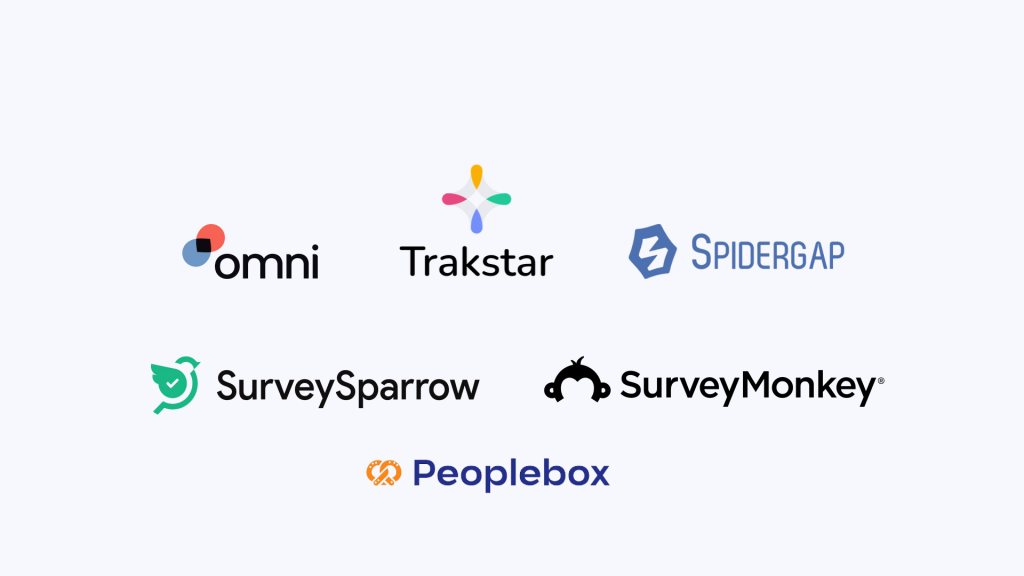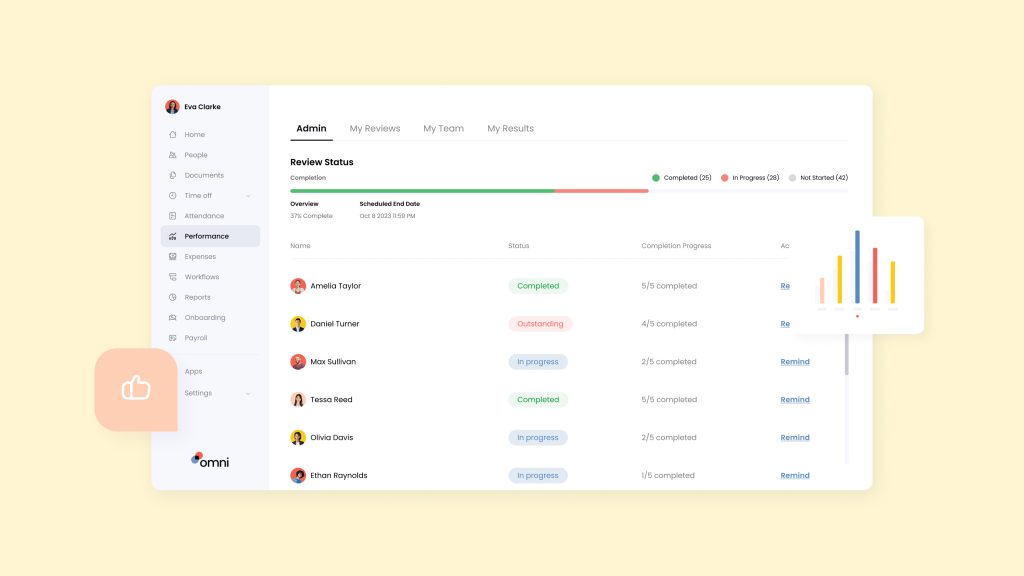If you’re looking in one direction, there’s only so much you can see. With a 360 degree feedback tool, you’ll have the complete picture of what’s going on around you. 360 feedback tools go to multiple sources to get the full view of your employee’s performance, and build a plan of action based on better information.
But this kind of feedback has a lot more moving parts than a simple performance review. With multiple sources to consider, and the number of people involved, more and more HR departments are turning to readily available 360 feedback tools to take advantage of the benefits 360 degree feedback can offer.
Here, we’re going to take a look at the best 360 feedback tools, and the characteristics you’re going to want to look for in them so that they make the biggest impact for your organization.
Relevant reading: A Guide to Mastering Performance Management
What is 360 degree feedback?
360 degree feedback (sometimes called multi-rater feedback) is a type of performance evaluation currently favored by many HR professionals. It gathers feedback from multiple sources about your employees performance, behaviors, and competencies and, unlike traditional performance reviews conducted by a single manager, 360 degree feedback involves collecting input from multiple team members.
The “360 degree” reflects the comprehensive nature of the feedback, which takes a look at all sides of an employee’s performance and contributions, with feedback taken from peers, subordinates and even sometimes external partners or clients. This holistic approach provides a well-rounded assessment of your employees’ strengths, weaknesses, and areas for improvement.
We’ve explored 360 degree feedback in previous blogs, but in short, it’s commonly used for everything from performance appraisal and leadership development to talent management, and employee development purposes. When effectively applied, it can promote self-awareness, identify blind spots, boost collaboration, and support professional growth and development.
Read next: Mastering 360 Degree Feedback: Definitions, Tips, and Tools
What are the benefits for 360 degree feedback?
As mentioned above, there’s a ton of advantages to 360 feedback. One person may have very specific insight into your employee’s performance, but not the full picture. Here’s how 360 feedback paints a complete portrait:
Provides a comprehensive evaluation
Rather than just one person giving their opinion, 360 degree feedback gathers input from multiple sources. This comprehensive approach offers a more holistic (and ideally accurate) assessment of your employees’ performance, behaviors, and strengths, providing insights from different perspectives, each with its own value.
Improves employee engagement and morale
Involving your employees in the feedback process can increase their sense of ownership and engagement with their own development. When employees feel that their opinions are valued and heard, they are more likely to feel motivated and committed to their work and the organization as a whole. On top of that, knowing their own feedback will come from their peers will encourage them to work collaboratively and bond as a team.
Enhances performance through targeted development
The feedback collected through 360 feedback assessments can identify areas of strength and areas for improvement for your employees. Armed with this information, they can create targeted development plans to address performance gaps, improve performance, and advance their career goals.
Foster a culture of open communication and feedback
Implementing a 360 degree feedback signals to your employees that your organization values open communication and continuous improvement. By encouraging feedback from multiple sources, your company can promote a culture where its employees’ are comfortable providing and receiving constructive feedback, increasing transparency, collaboration, and trust.
Overall, the benefits of 360 degree feedback extend beyond individual development to impact the culture of your organization, employee engagement, and performance outcomes. By leveraging multiple perspectives and promoting a culture of continuous feedback and improvement, organizations can unlock the full potential of their workforce and drive sustainable success.
What to consider when choosing a 360 degree feedback tool?

While the amount of technology available to choose from means lots of flexibility, it can also be a bit daunting, and make selecting the right solution for your organization difficult. Here are key aspects of the best 360 degree feedback tool you should consider:
1. Is it customizable?
Look for a 360 feedback tool that allows customization to align with your company’s mission, unique goals and performance criteria. The ability to tailor questions, rating scales, and feedback categories ensures that the assessment reflects your organization’s specific needs and objectives. It also means you can update the nature of the feedback your organization collects as it grows and evolves, reflecting its new aims.
2. Is it easy to use?
User experience is absolutely essential for the successful adoption of any 360 feedback tool. Choose a platform that is intuitive, user-friendly, and accessible across devices. Your employees should be able to navigate the tool easily, complete assessments efficiently, and access their feedback and development resources without unnecessary complexity.
3. Does it offer reporting and analytics?
A robust 360 feedback tool should provide comprehensive reporting and analytics capabilities to derive actionable insights from assessment data. Look for features such as customizable dashboards, trend analysis, and benchmarking tools to track progress, identify trends, and measure the impact of developmental interventions over time.
4. Does the tool prioritize data security?
Protecting sensitive employee data should be your top priority. Ensure the 360 feedback tool you choose adheres to industry-standard data security protocols and compliance requirements. Look for features such as encryption, role-based access controls, and regular security audits to safeguard the confidentiality and integrity of your employees’ data.
5. Can it integrate with your existing HR systems?
Seamless integration with your organization’s existing HR systems, such as performance management, learning management, and talent development platforms, is essential for data consistency and workflow efficiency. Choose a 360 feedback tool that offers robust integration capabilities or APIs to streamline data sharing and reporting processes.
6. Can the tool scale and adapt based on your needs?
As your organization evolves and grows, your feedback tool should be able to scale and adapt to accommodate changing needs and requirements. Consider factors such as scalability, flexibility, and vendor support when looking at potential solutions to make sure the 360 feedback tool you go with can grow with your organization and continue to meet your evolving needs over time.
By carefully considering these factors when selecting a 360 degree feedback tool, you can choose a solution that fits with your organization’s objectives, promotes employee engagement and development, and drives meaningful performance improvement across your workforce.
Best 360 Feedback Tools for 2024

With all that in mind, what are the 360 feedback tools which exemplify the characteristics we spoke about in the previous section? Here, we take a look at some of the best 360 feedback tools available and breakdown what they can do for your organization:
Omni
Omni offers a comprehensive suite of features for 360 degree feedback, including customizable performance assessments, real-time feedback tracking, and robust reporting and analytics. Our user-friendly interface and flexible customization options make it a popular choice for organizations seeking to enhance employee engagement and performance. And of course Omni is more than just a 360 feedback tool—it’s also a powerful HRIS which offers a comprehensive suite of high-caliber HR tools in addition to its 360 degree feedback enablement.
SurveySparrow
SurveySparrow’s 360 degree feedback tool is known for its intuitive design, tailored surveys, and advanced reporting capabilities. With features such as multi-rater assessments, automated reminders, and AI-powered insights, SurveySparrow helps different organizations gather actionable feedback and drive continuous improvement across their teams.
Peoplebox
Peoplebox is one of the top 360 degree feedback tool that integrates with your existing work tools like Slack, Microsoft Teams, Hubspot, and Asana to make your employees fall in love with reviews and feedback.
Its integration with Slack and Microsoft Teams goes beyond just notifications and allows your employees to update goals, write reviews, schedule 1-on-1 meetings and receive feedback. Alongside features like built in templates, form personalization, customer weightage for goals and more, Peoplebox helps organizations to drive performance, retention and business outcomes.
Trakstar
Trakstar’s 360 degree feedback platform helps organizations streamline the feedback process, track employee performance, and identify areas for development. With customizable assessment templates, real-time feedback tracking, and configurable reporting options, Trakstar can help organizations leverage feedback to drive individual and organizational growth.
SurveyMonkey
SurveyMonkey offers a user-friendly and versatile platform for conducting 360 degree feedback assessments. With a wide range of survey templates, customizable questionnaires, and powerful analytics tools, SurveyMonkey enables organizations to gather actionable feedback, identify strengths and areas for improvement, and drive performance improvement.
Spidergap
Spidergap’s 360 degree feedback tool is designed to simplify the feedback process and promote employee development. Like other options on this list, it features customizable assessments, automated feedback reminders, and interactive reporting dashboards. Spidergap helps organizations create a culture of continuous feedback and improve the performance of its team members.
Consider these 360 degree feedback tools for your organization—they offer a range of features and capabilities to support your team in gathering actionable feedback, driving employee engagement and development, and achieving your performance goals in 2024 and beyond.
Driving Performance and Engagement with Omni

Utilizing a 360 degree feedback tool suitable for your business needs can significantly boost your approach to enhance growth, development, and collaboration.
With a 360 degree feedback tool like Omni, managers, employees, and the HR teams that serve them can take full advantage of its many benefits. Omni simplifies the entire performance review process, making it easier for managers to customize performance review questions, schedule performance review cycles, and run performance review cycles. With our user-friendly interface and intuitive features, Omni ensures a seamless experience for both participants and administrators.
Omni’s performance review solution integrates seamlessly with the 360 degree feedback process, allowing you to consolidate feedback from various sources and present it in a comprehensive format. Our platform ensures anonymity and confidentiality, encouraging honest feedback from all participants for you to leverage for performance improvement.
Book a demo with our team today to learn more about how Omni is the 360 feedback tool for your business.


